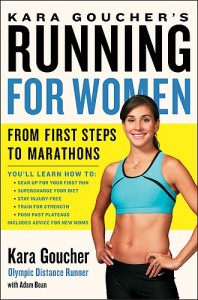Kara Goucher’s Tips for Finding the Perfect Running Shoes
We have a total girl-crush on Kara Goucher. She’s an awesome mom, reps Nike and runs LIKE THE DICKENS. A World Championship bronze medalist for the 10K and a top U.S. marathoner, we actually got to meet her at the Nike Women’s San Francisco Marathon in October 2009, and learned first-hand that she is also down to earth and totally sweet. (Side note: She also rocks a bling-tastic wedding ring that darn near blinded me with prettiness. Her hubs did good—and then some.)
Kara recently added “author” to her title of her many accomplishments after penning Kara Goucher’s Running for Women: From First Steps to Marathons. We pretty much love the book, which features a healthy dose of running inspiration and know-how, including tips and advice on everything from getting started to training plans to speed drills to nutrition and even running during pregnancy. The book rocks for anyone who is a runner or wants to become a runner.
Kara graciously offered to share a few of her top tips on a topic that we get questions about all the time: What type of running shoe should I buy? Kara has answers, ladies! (And they’re obviously working for her…)
 11 Tips for Buying Running Shoes
11 Tips for Buying Running Shoes
1. Go to a running store. Visit a specialty running store, and remember that fit is everything. So keep trying them on until you’re satisfied with how they feel.
2. Spend the money. Shoe experts normally recommend that you spend at least $80 on running shoes—though many cost well over $100. Of course, you can find them cheaper on the Internet or in discount stores, but in the case of the former, you don’t get to try them on, which is vital. As for the latter, you never know what you’re getting at a discount store, and the staff won’t be trained to help you find the right pair.
3. Pay attention to sore or fatigued lower legs. I actually don’t need to keep track of how many miles I put on my shoes. I can tell my shoes are toast when I feel flat or fatigued from the knees down during two or three runs in a row. I call this “running on boards” because my feet and legs aren’t getting the support they need from my shoes. Experts normally say the time-for-a-new-pair limit is about 500 miles—slightly more if you’re a superefficient runner, less if you’re a bigger runner or less efficient.
4. Buy a slightly bigger size. When buying running shoes, go for a half to a full size bigger than your normal street shoes, and simply lace them a bit more snugly. This will give your toes plenty of room so that they don’t slam into the front of your shoe.
5. Have two pairs of shoes at all times. This way you’ll always have a dry pair ready to go. They can be either the same model or different; it doesn’t really matter. The one nice thing about two different types is this forces your feet and legs to deal with slightly different biomechanics. It’s akin to a more well-rounded education for your brain.
6. Wear women’s running shoes as a rule, but men’s versions work for some. Women’s running shoes tend to be designed with a slightly narrower heel and wider forefoot section, to accommodate the shape of most women’s feet. But be flexible about this. If your feet are shaped such that they feel better in a men’s version, go with it! (It’ll be a secret only your shoe salesperson will know.)
7. Go with a men’s version for “normal” colors. Following the previous tip, if your feet do feel fine in a man’s running shoe (and fit is the most important parameter), you’ll have more color options in normal reds, blues, grays, silvers and blacks. Women’s versions tend to be pinks and pastels.
8. Go shoe shopping at the end of the day. It’s kind of gross, but feet tend to swell slightly at the end of the day after all the normal wear they get. So it’s a good idea to get fitted for a new pair during this time, to give your feet and toes plenty of room inside the shoe.
9. Try on both shoes when you’re getting fitted. Your feet can be slightly different in terms of length and shape, so be sure your shoes fit properly on both feet.
10. Keep your running shoes only for running. This ensures they’ll stay cleaner and last longer. But it’s also good to think of your running shoes as special. And, in fact, they are. They’re your trusted companion and are literally with you every step of the way on your running journey.
11. Recycle your kicks. There are lots of great causes and charities that need used running shoes, so bypass the landfill by donating yours. Shoe donation charities include shoe4africa.org, nikereuseashoe.com, hoperuns.org and giveyoursole.com.
We couldn’t agree more with these tips, especially the one about running shoes being “special.” It’s so true!
Want more words of wisdom from Kara Goucher? Watch Kara Goucher offer advice to runners and check out her book online! Happy running-shoe shopping! —Jenn
